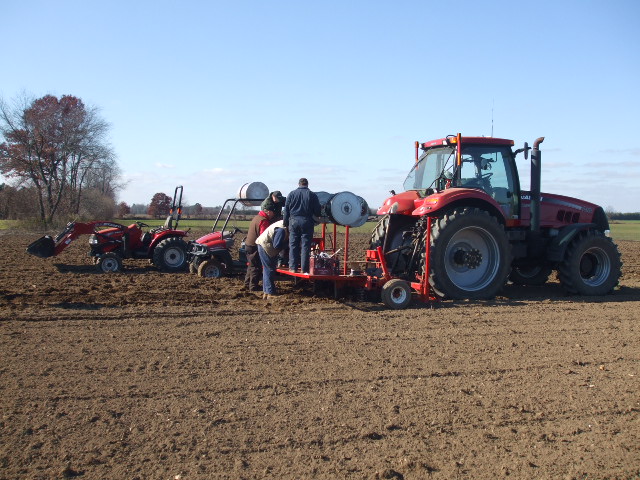Digging down for better crop yields
UTILIZING SUBSURFACE DRIP IRRIGATION
PRECIPITATION CHALLENGES ARE a lot less challenging for one Norfolk County farm that plants their crops on Ontario’s sand plains. It is one of the first farms in the province to tap into subsurface drip irrigation.
PHOTO: THE TEAM AT JUDGE FAMILY FARMS COLLABORATED TO CUSTOM BUILD THIS MACHINE TO LAY DRIP TAPE UNDERGROUND ON A LARGE SCALE.

Todd Boughner, farm manager for Judge Family Farms, says the subsurface drip irrigation is helping them balance crop needs with natural precipitation at the cash crop and livestock operation. “We’re at the mercy of the weather,” says Boughner, adding that the drought last year put increasing pressure on the need to improve water management on their cropland.
Six young farm families comprise Judge Family Farms in Simcoe. Together they manage broilers, hogs, grains and oil seed production, and have a grainery on site. Their cropland is split into 800 acres of soybeans and 1,800 to 2,000 acres of corn annually. Boughner says a key challenge is the land closest to the homestead is not suited to grain production – adding it requires high inputs for a mediocre crop result. Four years ago, he began exploring ways to improve the situation through the use of irrigation.
EXPLORING IRRIGATION OPTIONS
In their area, vegetable and tobacco growers dot the landscape and Boughner had observed the local tobacco farmers using different irrigation methods, including traveller irrigation systems – a framework on wheels fitted with hoses that shoot water overhead onto crops. So Judge Family Farms gave it a try on some of their corn acres.
They found the additional moisture certainly benefitted the crop – boosting average yields to about 160 bushels per acre. However, Boughner says it was frustrating watching so much of the water output get intercepted by the wind and sun. Boughner had heard about some American corn growers irrigating underground and wondered if it could work in Ontario.
The team at Judge Family Farms started talking to Netafim, a leader in smart drip and micro-irrigation solutions, as well as a local supplier. Boughner also talked with farmers in the US and learned about the benefits of subsurface drip. Boughner was able to ask questions and learn the basics of how each program worked. Very soon Judge Family Farms, along with interested neighbour Blake Farms, built their own drip tape applicator and organized the details of how to put in drip tape on a large scale.
THE INSTALLATION PROCESS
Modifications were made to the process, and the following fall Boughner and his team established subsurface drip irrigation in 55 acres, followed by 25 more acres the next spring. The field and irrigation pattern were divided into six zones for improved water management.
Using GPS guidance, a four-person team laid 13 millimetre drip tape 14 inches deep and in rows 44 inches apart. The thick walled drip tape has emitters spaced 24 inches apart to distribute the water. To connect all the tape rows, a PVC feed line and a PVC flush line were installed 40 inches deep across the two field ends.
“Moving to the 44-inch row spacing gives us more even field watering and gives us more variety in the types of crops that can be planted in the field,” Boughner says. Fed by an electric pump located near the pond, one zone watered for six hours can achieve 0.24 inches of water at the plant root.
A double sand filtration system installed at the pump house helps to clean the water before it flows to the tape. With the pumping capacity on farm, Boughner says they can effectively water two zones at once, spanning about 25 acres with 16 pounds of pressure. “Within 18 hours the entire field can be fully irrigated,” he says.
RESULTS
The results have been decisive. For two consecutive years Judge Family Farms partnered with Vanden Heede Farm to earn top prizes in the Ontario corn yield challenge with 300 plus bushels per acre. Boughner figures he has invested $1,500 plus labour costs per acre installing subsurface drip irrigation. “We’re expecting a two-to-three year payback on our investment,” he says.
System maintenance is a one-person job, checking in daily on the pump house to ensure all is as it should be. The site is equipped with wireless internet and Boughner sees a smart phone and real-time cameras becoming part of his monitoring abilities in the future.
Boughner is proud of the system the farm has in place and sees how it contributes to environmental sustainability in an era where water use will only become more tightly regulated. The drip tape enables him to decrease water usage by 75 percent. “Our pond will last for 50 acres of overhead tobacco watering or 200 acres of corn by subsurface drip,” he says.
This year, Boughner is eager to try spoon feeding nutrients to his crop using an injection point at the pump house. He will use plant tissue sampling to monitor the results. He is also studying the effects irrigation has on disease pressure.
“We know we can get high yields on sand,” Boughner says. “Now it’s figuring out how to do it better. •

















